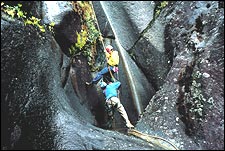WHEN RUDI DEBBAUT and nine other Belgians disappear into Borneo’s notorious Low’s Gully this month, they’ll be understandably jittery about water. The last time Debbaut, a 39-year-old caving instructor and canyoneer from Ghent, tried to exit the bottom of the jungly 6,000-foot abyss, he stayed soaked for five days and got a bad case of hypothermia. At one point during that 2000 trip, he bolted his hammock into a granite face to catch a few winks, only to be jolted awake by a thunderous roar. “Waterfalls suddenly appeared, one on each side of me,” he recalls. “I left that place fast. The water was too much.”
 Look out below: a Canadian team attempts Low’s Gully, March 2002.
Look out below: a Canadian team attempts Low’s Gully, March 2002.
But not so much that he won’t try again—this time as part of a team led by Paul Symons, a 49-year-old physician and explorer also based in Ghent. Symons has descended every major chasm in Europe, canyoneering’s current epicenter, and four of his team members have already attempted the Gully, which is located in Malaysia’s north-Borneo state of Sabah. If this soggy squad can survive the hydraulic mayhem and slosh all the way through to the Panataran River, five miles away, they’ll accomplish something unique: the first pull-through descent of the world’s riskiest canyon. For the uninitiated, “pull-through” is the rough equivalent of “without a net,” meaning the team will remove and carry its ropes as it rappels down Low’s, erasing any possibility of an emergency retreat up fixed lines. Once they pass the canyon’s narrow crux at New’s Pools, two-thirds of the way down, they’ll be forced to reach the end—or else.
The challenge they’re taking on is like nothing else in the world, a chasm whose depth and rainfall totals make it an exceptionally dangerous route. It was formed a million years ago, when massive glaciers gouged out the center of 13,455-foot Mount Kinabalu and bisected the summit into eastern and western plateaus, separated by the plunging Gully. When it rains at Low’s Gully, which is often—Borneo receives 13 feet annually—water spills from Kinabalu’s granite summit and races down sloping walls that narrow from 300 feet apart at the top to 15 feet at the bottom, where furious torrents crash into the Panataran.
“Two centimeters of rain at the summit can cause Class V whitewater halfway down the Gully,” says Chips Rafferty, 52, who in 1998 led a British and Malaysian group that made the first and only complete descent of the canyon. “The place can be truly sinister.”
Since 1991, when Britons Robert New and Steve Pinfield launched the inaugural expedition into the Gully, half a dozen teams have tried to reach bottom. The most famous attempt took place in 1994, when a squabbling British military contingent got lost and split into two groups, with one bunch getting stranded for three weeks without food before being choppered out.
Rafferty’s 1998 expedition succeeded largely because of lavish sponsorship money, helicopter support, 10,000 feet of fixed ropes, and, significantly, a rare stretch of El Ni-o-assisted dry weather. In 2000, a British and Belgian team that included Debbaut tried a descent, but to the Belgians’ dismay, the Brits radioed for helicopter evacuation after running into fast water halfway down. “It was like grabbing a taxi,” complains Debbaut. “They were too fast in their decision.”
Such a rescue is out of the question this time. Malaysian officials, tired of plucking Europeans from the canyon, have warned the Belgians to forget about air support. The expedition is trying to retain a private helicopter in case of a dire emergency, but the $30,000 epic, which is largely self-funded, will mostly be on its own.
The self-reliance starts at the trailhead, with expedition members strapping on 55-pound packs and trekking up through the jungle to the edge of Kinabalu’s western plateau, where they’ll establish camp at a park hut called Sayat-Sayat, near the Gully’s rim, at 12,500 feet. From there, they’ll spend two to three days waking at 4 a.m. to avoid afternoon rains and executing multiple 100-foot rappels down icy waterfalls through a spillway called Commando Cauldron, a stretch that also requires boulder-hopping, butt-sliding, jungle-hacking, and swimming across deep pools.
The end of the road for most expeditions comes at New’s Pools, a series of cascades at 7,500 feet. At this point the canyon’s towering walls narrow to less than 100 feet apart, horizontal surfaces disappear, and even a mild drizzle at the summit sends water blasting through. If the Belgians survive it, they’ll hunker down and pray for a rain-free window so they can blitz to the bottom, then walk a day to their pickup point at the village of Melangkap Kappa.
With a ten-day food supply for the journey, the Belgians figure they can wait out the rain if something goes wrong. If not, they’ll have to hack a route through the jungle and exit the Gully via one of its steep sides.
Ultimately, success or failure really depends on the rain. “Canyoneering is about water,” says Debbaut. “You descend into the water; you play in the water. The problem is when everything shifts—then the water plays with you.”


